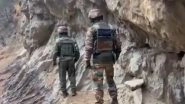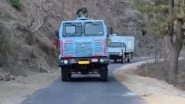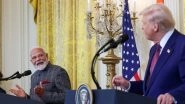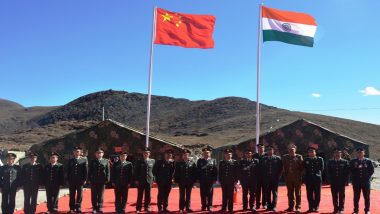New Delhi, July 25: In a significant development, troops of India and China have completed disengagement at Galwan Valley, Patrolling Point 15, and Hot Springs/Gogra area in Eastern Ladakh amid the ongoing talks at the diplomatic and military level, sources said.
"The ongoing engagement and dialogue between India and China at the military and diplomatic levels has resulted in complete disengagement at Patrolling Point 14 (Galwan area), 15 and 17 A (Hot Springs/Gogra) in eastern Ladakh," a source told ANI here. Also Read | ACP Traffic Sanket Dies After Accident at Rajokri Flyover, Says Delhi Police: Live News Breaking And Coronavirus Updates on July 25, 2020.
The sources said that after disengagement in these areas as per agreements in the last Corps Commander-level talks, the only area where disengagement is left to be implemented is the Finger area along the Pangong Tso lake.
A meeting between the senior military commanders is expected in the coming week to further work out modalities of the Pangong Tso lake area, they added. Also Read | Here's How to Identify & Stop Bully Friends Online.
Even though disengagement has been taking place between the two sides, the Chinese have not begun the process of de-escalation along the LAC opposite Eastern Ladakh where they have maintained a build-up of close to 40,000 troops with heavy weaponry deployed in front and depth areas.
India has made it clear that for the situation to be normalized, the Chinese will have to completely deescalate and move back troops to their permanent locations.
India and China had reviewed the situation on Friday in the India-China border areas at the 17th meeting of the Working Mechanism for Consultation and Coordination (WMCC) and agreed that early and complete disengagement of the troops along the Line of Actual Control (LAC), de-escalation from India-China border areas and full restoration of peace and tranquillity was essential for the smooth overall development of bilateral relations.
They also agreed that another meeting of senior commanders may be held soon so as to work out further steps to ensure expeditiously complete disengagement and de-escalation. The Indian delegation was led by Joint Secretary (East Asia) in the External Affairs Ministry and Director General of Boundary and Oceanic Dept of Chinese Ministry of Foreign Affairs led the Chinese delegation.
An External Affairs Ministry release had said that the two sides reviewed the situation in the India-China border areas and the ongoing disengagement process along the Line of Actual Control (LAC )in the Western Sector.
"They agreed that early and complete disengagement of the troops along the Line of Actual Control (LAC) and de-escalation from India-China border areas in accordance with bilateral agreement and protocols and full restoration of peace and tranquillity was essential for the smooth overall development of bilateral relations," the release said.
The two sides noted that this was in accordance with the agreement reached between the two Special Representatives (SRs) during their telephonic conversation on July 5, 2020.
The two countries have held military and diplomatic consultations following a face-off between troops of two sides in Eastern Ladakh and the military build-up by China.
WMCC was established in 2012 as an institutional mechanism for consultation and coordination for the maintenance of peace and tranquillity in the India-China border areas, as well as to exchange views on strengthening communication and cooperation, including between their border security personnel.
(The above story is verified and authored by ANI staff, ANI is South Asia's leading multimedia news agency with over 100 bureaus in India, South Asia and across the globe. ANI brings the latest news on Politics and Current Affairs in India & around the World, Sports, Health, Fitness, Entertainment, & News. The views appearing in the above post do not reflect the opinions of LatestLY)













 Quickly
Quickly


